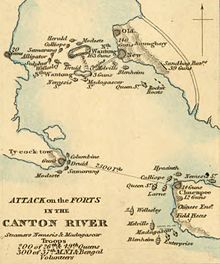Battle of the Humen
| date | February 23, 1841 to February 26, 1841 |
|---|---|
| place | Humen , China |
| output | British victory |
| Parties to the conflict | |
|---|---|
| Commander | |
| Troop strength | |
| 12 ships 1037 infantry 3 cannons |
30 junks 2000 infantry Approx. 500 cannons |
| losses | |
|
5 wounded |
Approx. 500 dead and |
The Battle of the Humen took place between British and Chinese forces during the First Opium War . The British expedition fleet under Charles Elliot managed to bring the coastal fortifications on the shipping route to the southern Chinese city of Canton under their control.
prehistory
During the First Opium War, the Chinese Emperor Daoguang tried to end the opium trade in Canton through his High Commissioner Lin Zexu . Great Britain took the actions of Lix Zexus, who forced the foreign opium dealers in the enclave of the Thirteen factories to surrender their opium reserves, as an opportunity to send a fleet. The aim of the British was to receive financial compensation and to force China to establish trade relations determined by Great Britain through a show of military force. After the British had captured the island of Zhoushan as a base of operations, they turned again to Canton, where they hoped to conclude a diplomatic agreement through military pressure.
The shipping route known as the Lion Gate (Chin .: Humen , Latin: Bocca Tigris ) from Canton across the Pearl River Delta to the open sea had been paved since the Ming Dynasty . In 1810 the coastal defense, which was based on forts and artillery, was supplemented by a coastal navy organized at the provincial level. In 1834 there was a brief skirmish on the occasion of the failed mission of Lord Napier . As a result, Guan Tianpei was appointed by the emperor to command the Guangdong Coastal Navy . This extended the fortifications of the Humen further. Guan's original plan consisted of three lines of defense. Each two artillery units on the islands of Sandkap and Großkap should at sighting the enemy by their fire alarm the second line. This was centered on the fort on Upper Hengdang Island in the canal and was flanked by forts on both sides of the river. Here Guan stationed most of his artillery with 180 cannons. A third line of defense around the Dahu fort upstream had 36 cannons. The aim of the defense was to prevent British ships from marching past Canton. The British had already captured the outermost line of defense in the Second Battle of Chuenpi in January 1841. In total, around 2,000 men were supposed to occupy the forts during wartime. Due to the tension with the British, the troops had been reinforced by Lin Zexu and the governor-general of Guangdong and Guangxi Deng Tingzhen . At the time of the battle there were around 10,000 regular and irregular Qing Army combatants on the Humen. Ten warships and a large number of fire boats were also assigned to the third line of defense.
Charles Elliot saw the military reinforcement of the Humen as a sign of the Chinese government's unwillingness to cooperate and tried to prevent this through military action. In view of the military preparations, the British leadership doubted that China would comply with the agreement of the Chuenpi Convention agreed after the Second Battle of Chuenpi . On February 22, 1841, the Nemesis destroyed Chinese fortifications under construction in a side canal. on February 24, 1841, the British issued Guan the ultimatum to let British troops occupy his Second Line. If this does not happen, violence would be used.
course
The actual battle began on February 26, 1841 in the early hours of the morning with the dropping of a landing force on the Lower Hengdan Island, which was opposite the central Chinese fort on the second line. From this position the British ground forces took the fort under fire with artillery. Meanwhile warships were advancing on both sides of the canal and taking the forts there under fire. After the fort could no longer offer any resistance , the Nemesis dropped ground troops on the Upper Hengdang Island. The troops there were trapped. After around 250 dead and 100 wounded, the remaining 1,000 Chinese soldiers capitulated. Guan Tianpei was killed while defending the fort. By evening the British managed to occupy the fortifications of the second line. In addition, other forts were briefly captured and the artillery there destroyed or captured.
consequences
According to British data, their losses amounted to five slightly wounded.
The renewed military defeat contributed decisively to the recall of Qishan as special envoy of the emperor responsible for the problems with the British. Qishan was recalled after the emperor finally rejected the Chuenpie Convention because of the surrender of Hong Kong . The military defeats made his Chinese contemporaries look like treason. Qishan was replaced by the noble Yishan .

